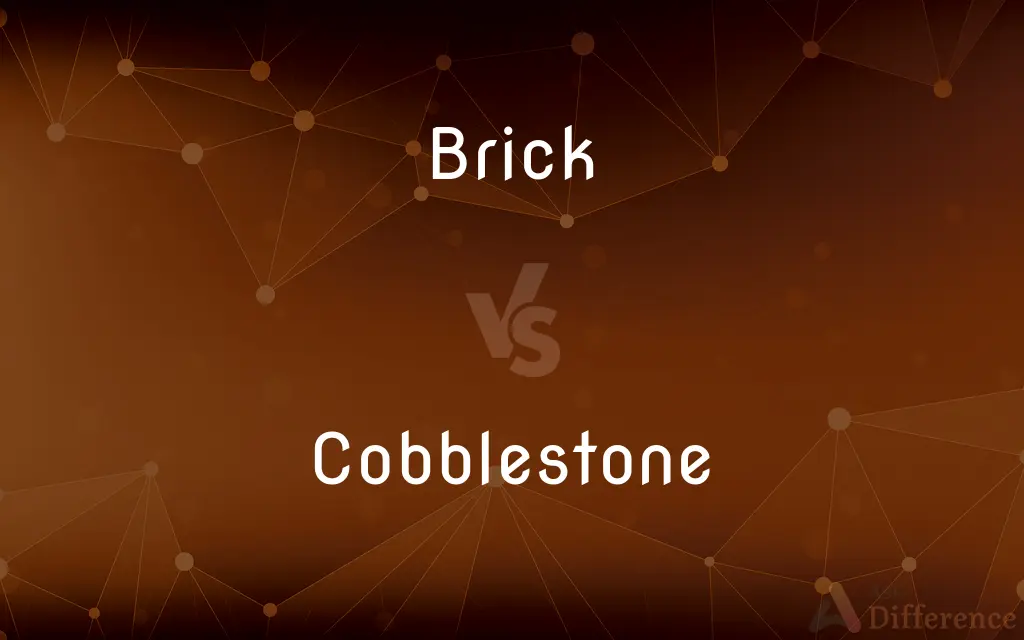Brick vs. Cobblestone — What's the Difference?
By Fiza Rafique & Urooj Arif — Updated on March 27, 2024
Brick is a rectangular building material made from clay and fired in a kiln, commonly used for walls and pavements, offering a range of colors. Cobblestone, rounded and made from naturally occurring stones, is used for paving streets.

Difference Between Brick and Cobblestone
Table of Contents
ADVERTISEMENT
Key Differences
Bricks, known for their rectangular shape and uniform size, are manufactured from clay or shale. On the other hand, cobblestones are naturally occurring stones, typically granite, rounded through the ages by flowing water. They are collected and used, particularly in paving, to create surfaces with a distinctive, often historical look. Cobblestone streets are renowned for their durability and permeability, allowing rainwater to filter through and reduce runoff.
While bricks offer a more uniform and smooth surface, making them ideal for both structural and decorative purposes, cobblestones, with their irregular shapes and sizes, provide a unique aesthetic that evokes a sense of history and charm. However, cobblestone surfaces can be uneven, making them less suitable for areas requiring accessibility or frequent use by bicycles and strollers.
In terms of installation, brick laying involves a systematic approach, using mortar to bond the bricks together into a cohesive structure. This process allows for a wide variety of patterns and designs. Cobblestone installation, however, is more labor-intensive, requiring each stone to be set individually by hand into a sand or mortar bed, which can be time-consuming and requires skilled craftsmanship.
Environmentally, both materials offer benefits. Bricks, made from abundant natural clay, can be recycled and reused, while their thermal mass helps with energy efficiency in buildings. Cobblestones, being natural stones, have a low environmental impact in terms of production but may involve significant transportation if not locally sourced.
From a historical perspective, bricks have been used in construction for thousands of years, with their use and manufacturing techniques evolving over time. Cobblestones have also served as a traditional paving material, especially in Europe, where they are synonymous with old-world city streets and rural paths, contributing significantly to the character and heritage of landscapes.
ADVERTISEMENT
Comparison Chart
Composition
Made from clay or shale, fired in a kiln.
Naturally occurring stones, typically granite.
Shape
Uniform, rectangular.
Rounded, irregular.
Color Range
Red, yellow, brown, depending on the clay.
Natural stone colors, varies widely.
Use
Walls, pavements, decorative elements.
Paving streets, walkways, historic areas.
Installation
Laid in patterns with mortar.
Set individually by hand in sand or mortar.
Durability
High, with low maintenance.
Very high, resistant to heavy wear.
Surface
Smooth, can be slip-resistant.
Uneven, can be slippery when wet.
Environmental Impact
Low, materials are abundant, can be recycled.
Low production impact, transportation varies.
Historical Use
Widespread in ancient to modern construction.
Traditional in Europe, historic streets and paths.
Aesthetic
Uniform and orderly, warm colors.
Historic, varied, adds character.
Compare with Definitions
Brick
A durable building material made from fired clay.
The brick house remained sturdy for centuries.
Cobblestone
Provides a unique, historical aesthetic.
The cobblestone lane added charm to the historic district.
Brick
Low maintenance and energy-efficient.
The brick building had excellent thermal mass, reducing heating costs.
Cobblestone
Rounded stones used historically for paving.
The old town's streets were paved with cobblestone.
Brick
Offers a range of colors and finishes.
Red bricks are popular for their traditional look.
Cobblestone
Made from natural granite, often hand-set.
Skilled workers hand-laid the cobblestone walkway.
Brick
Ideal for structural and decorative uses.
They chose brick for both the facade and the garden path.
Cobblestone
Durable and permeable paving material.
Cobblestone streets have withstood centuries of use.
Brick
Used in various patterns and designs.
The wall featured an intricate herringbone brick pattern.
Cobblestone
Can be uneven, challenging for accessibility.
The cobblestone surface made wheelchair access difficult.
Brick
A brick is a type of block used to build walls, pavements and other elements in masonry construction. Properly, the term brick denotes a block composed of dried clay, but is now also used informally to denote other chemically cured construction blocks.
Cobblestone
Cobblestone is a natural building material based on cobble-sized stones, and is used for pavement roads, streets, and buildings. Setts, also called Belgian blocks, are often casually referred to as "cobbles", although a sett is distinct from a cobblestone by being quarried or shaped to a regular form, whereas cobblestone is generally of a naturally occurring form and is less uniform in size.
Brick
A small rectangular block typically made of fired or sun-dried clay, used in building.
Cobblestone
A paving stone, especially one that is naturally rounded.
Brick
A large and relatively heavy mobile phone, typically an early model with limited functionality
I had one of those Motorola bricks as my first cell phone
Cobblestone
A rounded stone from a river bed, fit for use as ballast in ships and for paving roads.
Brick
A generous, helpful, and reliable person
‘You are really a brick, Vi,’ Gloria said
Cobblestone
(uncountable) The material made from cobblestones.
Brick
Block or enclose with a wall of bricks
The doors have been bricked up
Cobblestone
A large pebble; a rounded stone not too large to be handled; a small boulder; - used for paving streets and for other purposes.
Brick
Throw bricks at
The pub was attacked and windows in the area were bricked
Cobblestone
Rectangular paving stone with curved top; once used to make roads
Brick
Cause (a smartphone or other electronic device) to become completely unable to function, typically on a permanent basis
Installing an unofficial OS voids the warranty and may brick the phone
Brick
Be extremely worried or nervous.
Brick
A molded rectangular block of clay baked by the sun or in a kiln until hard and used as a building and paving material.
Brick
Such blocks of clay used as a building material
A house made of brick.
Brick
An object shaped like such a block
A brick of cheese.
Brick
(Informal) A smartphone, tablet, or similar electronic device that connects to the internet that has become inoperable.
Brick
A dark brownish red.
Brick
(Informal) A helpful, reliable person.
Brick
(Basketball) A shot that falls short of the basket.
Brick
To construct, line, or pave with bricks.
Brick
To close or wall with brick
Bricked up the windows of the old house.
Brick
(Informal) To cause to become inoperable. Used especially of electronic devices, such as smartphones and tablets, that connect to the internet. I bricked my smartphone when I tried to untether it.
Brick
(Informal) To become inoperable. Used especially of electronic devices, such as smartphones and tablets, that connect to the internet.
Brick
(countable) A hardened rectangular block of mud, clay etc., used for building.
This wall is made of bricks.
Brick
(uncountable) Such hardened mud, clay, etc. considered collectively, as a building material.
This house is made of brick.
Brick
(countable) Something shaped like a brick.
A plastic explosive brick
Brick
A helpful and reliable person.
Thanks for helping me wash the car. You're a brick.
Brick
A shot which misses, particularly one which bounces directly out of the basket because of a too-flat trajectory, as if the ball were a heavier object.
We can't win if we keep throwing up bricks from three-point land.
Brick
(informal) A power brick; an external power supply consisting of a small box with an integral male power plug and an attached electric cord terminating in another power plug.
Brick
An electronic device, especially a heavy box-shaped one, that has become non-functional or obsolete.
Brick
A projectile.
Brick
(firearms) A carton of 500 rimfire cartridges, which forms the approximate size and shape of a brick.
Brick
(poker slang) A community card (usually the turn or the river) which does not improve a player's hand.
The two of clubs was a complete brick on the river.
Brick
The colour brick red.
Brick
(slang) A kilogram of cocaine.
Brick
Extremely cold.
Brick
(transitive) To build, line, or form with bricks.
Brick
(transitive) To make into bricks.
Brick
To hit someone or something with a brick.
Brick
To make an electronic device nonfunctional and usually beyond repair, essentially making it no more useful than a brick.
My VCR was bricked during the lightning storm.
Brick
To blunder; to screw up.
Brick
A block or clay tempered with water, sand, etc., molded into a regular form, usually rectangular, and sun-dried, or burnt in a kiln, or in a heap or stack called a clamp.
The Assyrians appear to have made much less use of bricks baked in the furnace than the Babylonians.
Brick
Bricks, collectively, as designating that kind of material; as, a load of brick; a thousand of brick.
Some of Palladio's finest examples are of brick.
Brick
Any oblong rectangular mass; as, a brick of maple sugar; a penny brick (of bread).
Brick
A good fellow; a merry person; as, you 're a brick.
Brick
To lay or pave with bricks; to surround, line, or construct with bricks.
Brick
To imitate or counterfeit a brick wall on, as by smearing plaster with red ocher, making the joints with an edge tool, and pointing them.
Brick
Rectangular block of clay baked by the sun or in a kiln; used as a building or paving material
Brick
A good fellow; helpful and trustworthy
Common Curiosities
Why are cobblestone streets considered historic?
Cobblestone streets are considered historic due to their long history and characteristic appearance in old towns.
What is the primary material of brick?
Brick is primarily made from clay or shale.
Can bricks be recycled?
Yes, bricks can be recycled and reused in construction and landscaping.
How are bricks colored?
Bricks get their color from the natural color of the clay used and the firing process.
What makes cobblestones durable?
Cobblestones are made from hard, natural stone, making them very durable against wear and weather.
What is a common challenge with cobblestone paving?
Cobblestone paving can be uneven and slippery when wet, posing challenges for accessibility.
How does the environmental impact of brick and cobblestone compare?
Both have low environmental impacts in terms of production, but transportation can vary, especially for cobblestones if not sourced locally.
What is the significance of brick in historical construction?
Brick has been a fundamental building material throughout history, valued for its durability, fire resistance, and aesthetic versatility.
Are cobblestones made from other materials besides granite?
While granite is common, cobblestones can also be made from other durable stones.
What is a popular use of brick in modern construction?
Bricks are popular for facades, walls, and decorative elements in modern construction.
How do cobblestones contribute to drainage?
The gaps between cobblestones allow water to permeate, reducing runoff and enhancing drainage.
What architectural styles favor brick?
Brick is favored in Colonial, Victorian, and Modern architectural styles for its versatility and aesthetic appeal.
How is the installation process different for brick and cobblestone?
Brick installation uses mortar and follows specific patterns, while cobblestone is set by hand in sand or mortar, requiring skilled craftsmanship.
What are the maintenance requirements for cobblestone?
Cobblestone requires minimal maintenance but may need repositioning or cleaning to maintain its appearance and safety.
Can brick and cobblestone be used together?
Yes, brick and cobblestone can be used together, often seen in pathways and patios for a mix of textures and colors.
Share Your Discovery

Previous Comparison
Big vs. Bigg
Next Comparison
Article vs. ManuscriptAuthor Spotlight
Written by
Fiza RafiqueFiza Rafique is a skilled content writer at AskDifference.com, where she meticulously refines and enhances written pieces. Drawing from her vast editorial expertise, Fiza ensures clarity, accuracy, and precision in every article. Passionate about language, she continually seeks to elevate the quality of content for readers worldwide.
Co-written by
Urooj ArifUrooj is a skilled content writer at Ask Difference, known for her exceptional ability to simplify complex topics into engaging and informative content. With a passion for research and a flair for clear, concise writing, she consistently delivers articles that resonate with our diverse audience.















































